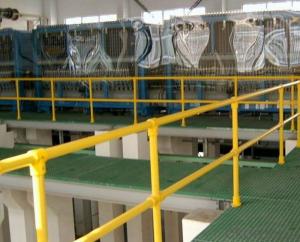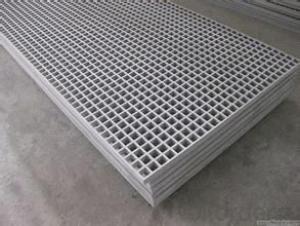FRP grating full colours as your requirement with insulation
- Loading Port:
- Shanghai
- Payment Terms:
- TT OR LC
- Min Order Qty:
- 10 pc
- Supply Capability:
- 8000 pc/month
OKorder Service Pledge
OKorder Financial Service
You Might Also Like
Specification:
FRP molded grating made of vertical and horizontal continuous fiberglass fully soaked in unsaturated polyester resin giving perfect bi-directional mechanical properties. Combining unmatched corrosion resistance with strength, long life and safety, molded grating provide the ultimate in reliable performance, even in the most demanding corrosive conditions. Besides, it is easy to cut and install. CNBM offer the widest selection with panel sizes, colors and slip resistant surfaces, clients can avail FRP grating your specific requirements.
Product Features:
- Light but high loaded strength
- High anti-corrosion and anti-aging
- Easy installation and maintenance
- Low maintenance
- Non-conductive
- Lowest in life cycle cost
- Corrosion Resstance
- Anti-slippery
- Various sizes and color available
Colour Design:
To satisfy customer's design project, CNBM grating offers a wide selection of grating colors to choose from. The standard colors available for fiberglass grating as following:
- Blue
- Red
- Yellow
- Green
- Light Grey
- Dark Grey
Custom colors of fiberglass grating may be available upon request, you can contact us learn more.
Moded Grating Sizes List:
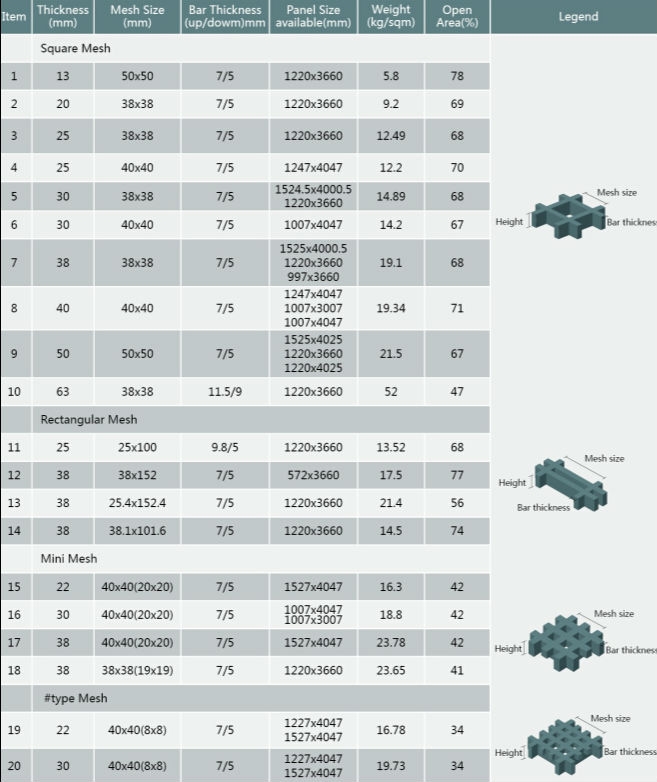
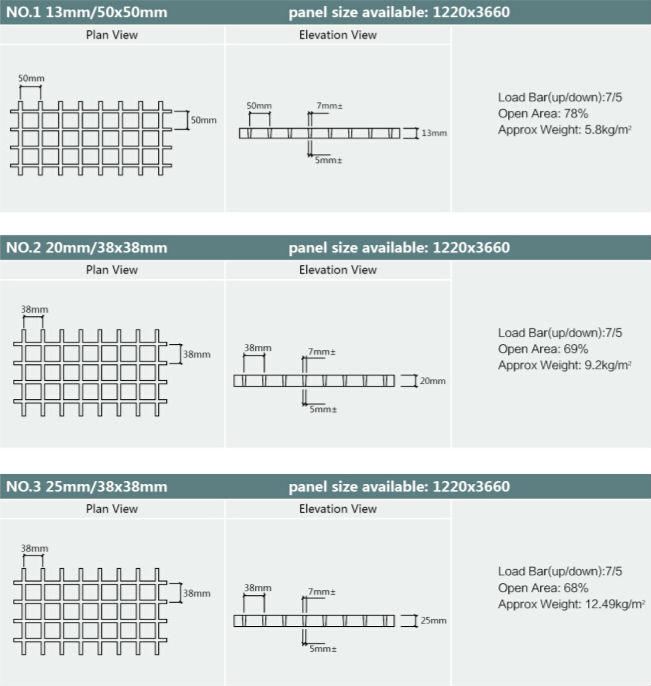

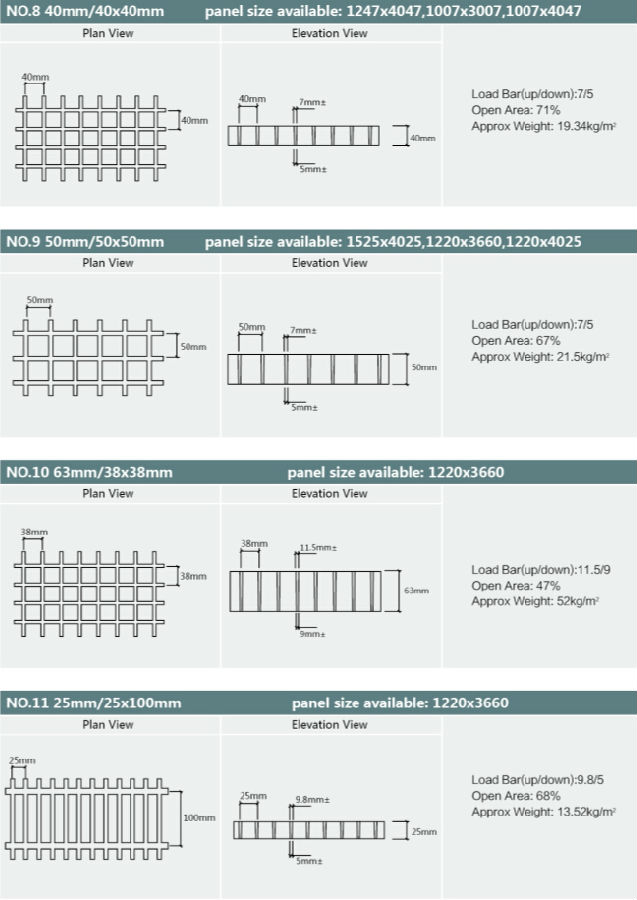
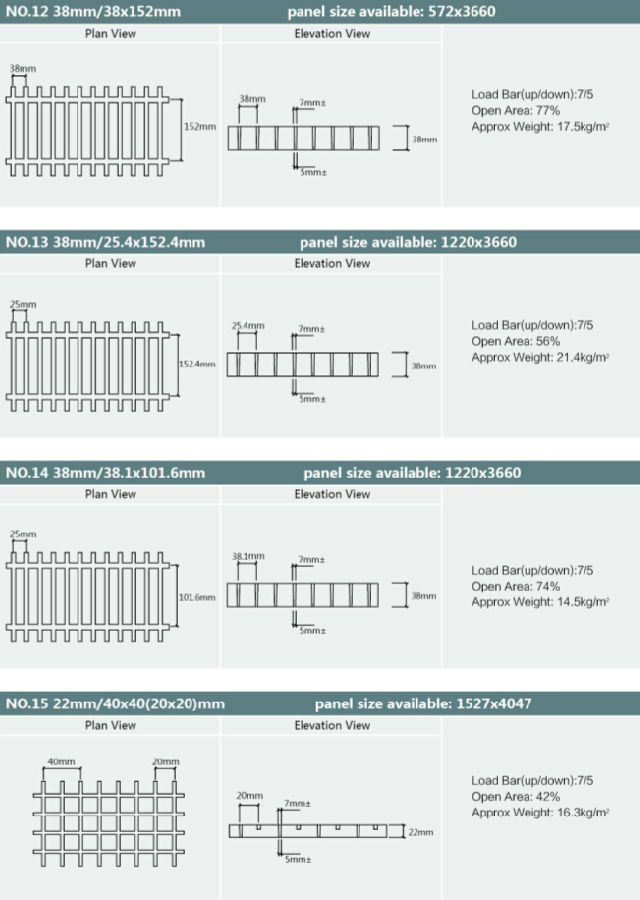
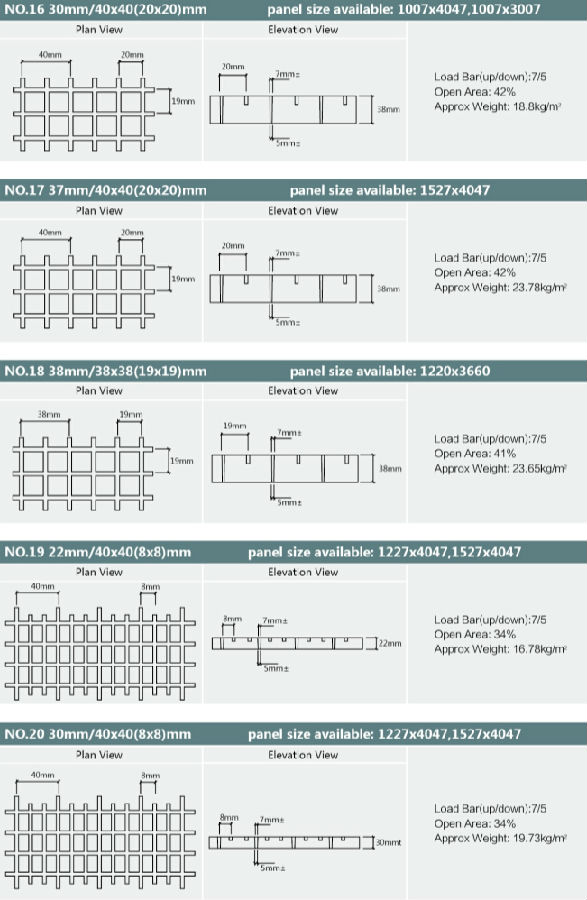
- Q:Are FRP pultrusion profiles resistant to chemicals used in food processing?
- The resistance of FRP pultrusion profiles to chemicals commonly used in food processing is generally high. FRP, a type of fiberglass reinforced plastic, is well-known for its exceptional chemical resistance, making it a suitable material for various industrial uses, including the food processing industry. These profiles are made by combining resins and fiberglass reinforcements, which give them inherent resistance to a wide array of chemicals. Acids, alkalis, solvents, and many other chemicals often found in food processing environments are typically resisted by FRP pultrusion profiles. This resistance ensures that the profiles will not corrode, degrade, or react with these chemicals, thus maintaining their structural integrity over time. Consequently, FRP pultrusion profiles are regarded as a dependable choice for equipment, structures, and components used in food processing facilities. However, it is important to note that the specific chemical resistance of FRP pultrusion profiles may vary depending on the resin system used in their production. Different resins offer different levels of resistance to specific chemicals. Therefore, it is crucial to carefully select the appropriate resin formulation that matches the specific chemical environment in the food processing industry. To ensure the compatibility of FRP pultrusion profiles with the chemicals commonly used in food processing, it is advisable to consult with the manufacturer or supplier. They can provide detailed information regarding the chemical resistance properties of their FRP profiles and assist in selecting the most suitable materials for the specific application. Additionally, proper maintenance and regular cleaning practices should be implemented to ensure the longevity and sustained chemical resistance of FRP pultrusion profiles in food processing environments.
- Q:What are the limitations of using FRP pultrusion profiles?
- When selecting materials for a particular application, it is crucial to take into account several limitations associated with the use of FRP (Fiber Reinforced Polymer) pultrusion profiles. Firstly, FRP pultrusion profiles have limited design flexibility due to their fixed cross-sectional shape, which is a result of the continuous manufacturing process. This restricts the ability to create complex or custom profiles, making them less flexible in design compared to metals or plastics. Secondly, FRP materials are susceptible to UV degradation. Prolonged exposure to sunlight can cause fading, discoloration, and loss of mechanical properties. To ensure long-term durability in outdoor applications, it is necessary to implement proper surface coatings or UV protection measures. Thirdly, FRP pultrusion profiles generally have lower impact resistance compared to metals. While they offer excellent strength-to-weight ratios, they may be more prone to damage from impacts or heavy loads. Therefore, careful handling and structural reinforcement may be necessary to mitigate the risk of damage. Additionally, FRP materials have a relatively high coefficient of thermal expansion compared to metals. This means that they will expand and contract significantly with changes in temperature. Proper allowances and design calculations must be made to ensure dimensional stability and prevent issues such as buckling or warping. Furthermore, FRP pultrusion profiles are generally combustible and can contribute to the spread of fire. While some FRP materials can be formulated with fire-retardant additives, they may still not meet the stringent fire safety requirements of certain applications. In situations where fire resistance is critical, alternative materials with better fire resistance properties may be preferred. Lastly, it is important to consider cost considerations when choosing FRP pultrusion profiles. They can be more expensive compared to traditional materials like steel or aluminum, especially when specialty reinforcements or additives are involved. However, the overall life cycle cost, including maintenance, durability, and weight savings, should be considered to determine the cost-effectiveness of FRP profiles for a specific application. Therefore, it is crucial to carefully evaluate these limitations and compare them against the specific requirements and constraints of the intended application to determine whether FRP pultrusion profiles are the most suitable materials to use.
- Q:Are FRP pultrusion profiles resistant to impact from flying debris?
- FRP (Fiber Reinforced Polymer) pultrusion profiles are known for their high strength and durability. They are generally resistant to impact from flying debris due to their inherent properties. The combination of the reinforcing fibers, typically made of fiberglass, and the polymer matrix provides excellent impact resistance. The specific resistance to impact from flying debris can vary depending on the specific design, thickness, and composition of the FRP pultrusion profiles. However, in most cases, these profiles are designed to withstand impact forces and can effectively resist damage caused by flying debris. Furthermore, FRP pultrusion profiles are often used in applications where impact resistance is crucial, such as in construction, transportation, and infrastructure industries. These profiles have been tested and proven to withstand various impact scenarios, making them a reliable choice for applications where flying debris is a concern. It is important to note that while FRP pultrusion profiles offer good impact resistance, the severity of the impact and the velocity of the flying debris can still affect the level of damage. Therefore, it is advisable to consult with the manufacturer or engineer to ensure the specific FRP profile chosen is suitable for the intended application and potential impact conditions.
- Q:What are the typical applications of FRP pultrusion profiles?
- The typical applications of FRP pultrusion profiles include structural components for infrastructure projects such as bridges and buildings, electrical insulation and support systems, corrosion-resistant equipment and storage tanks, ladder and handrail systems, and various other industrial and commercial applications where lightweight, high-strength, and durable materials are required.
- Q:Can FRP pultrusion profiles be used in the transportation and logistics industry?
- Yes, FRP pultrusion profiles can be used in the transportation and logistics industry. These profiles offer a lightweight and high-strength alternative to traditional materials like steel or aluminum. They are resistant to corrosion, have excellent dimensional stability, and can be customized to meet specific design requirements. FRP pultrusion profiles are commonly used in applications such as truck bodies, trailers, shipping containers, and infrastructure for transportation and logistics purposes.
- Q:Are FRP pultrusion profiles resistant to fungi and mold?
- FRP pultrusion profiles exhibit a general resistance to fungi and mold. This is attributed to the non-porous qualities of the construction materials, namely fiberglass and epoxy resins. These materials create an inhospitable environment for fungi and mold, thus establishing a high level of resistance against their proliferation and colonization. Moreover, FRP pultrusion profiles possess inherent moisture resistance, adding another deterrent to fungi and mold growth. In contrast to wood and its propensity to absorb moisture, FRP profiles do not retain water, rendering them highly resistant to these concerns. The combination of impermeable materials and moisture resistance make FRP pultrusion profiles an ideal choice for environments necessitating fungi and mold resistance, particularly those with high humidity or dampness. However, it is important to acknowledge that no material is entirely impervious to fungi and mold growth in all circumstances. In extreme conditions characterized by prolonged exposure to substantial levels of moisture and organic matter, there remains a possibility for some fungi and mold to colonize FRP profiles. Nevertheless, when compared to alternative materials, FRP pultrusion profiles offer a significantly superior level of resistance against these challenges.
- Q:Are FRP pultrusion profiles electrically conductive?
- Typically, FRP pultrusion profiles lack electrical conductivity due to the utilization of a blend of fiberglass reinforcement and a thermosetting resin matrix. These components offer exceptional insulation qualities. The inherent non-conductive nature of the fiberglass reinforcement is further amplified by the resin matrix. Consequently, FRP pultrusion profiles find frequent application in situations where electrical conductivity is undesirable or poses safety hazards. Nevertheless, it is noteworthy that specific modifications or additions can be implemented during the pultrusion process to introduce electrical conductivity, if needed for particular applications.
- Q:How do FRP pultrusion profiles perform in extreme temperatures?
- FRP pultrusion profiles are known for their excellent performance in extreme temperatures. Due to their unique composition of fiberglass and resin matrix, they are highly resistant to thermal expansion and contraction. This means that even in extremely cold or hot environments, FRP profiles maintain their structural integrity without warping or deforming. In high-temperature conditions, FRP pultrusion profiles exhibit remarkable dimensional stability and do not soften or melt like some other materials. They have a high glass transition temperature, which allows them to withstand even the most extreme heat without losing their strength or shape. This makes FRP profiles suitable for applications such as furnace components, exhaust systems, and industrial ovens. On the other hand, in extremely cold temperatures, FRP pultrusion profiles remain tough and durable. They do not become brittle or prone to cracking like traditional materials such as metal or concrete. This makes them suitable for use in cold storage facilities, refrigerated trucks, and other low-temperature environments. Furthermore, FRP pultrusion profiles have excellent resistance to chemical corrosion. They are not affected by exposure to various chemicals or solvents, making them suitable for use in harsh chemical processing environments. This resistance to chemical corrosion also extends to extreme temperatures, further enhancing their performance in such conditions. Overall, FRP pultrusion profiles have proven to be reliable and versatile materials in extreme temperature environments. Their ability to maintain structural integrity, dimensional stability, and resistance to chemical corrosion make them a preferred choice for various industries and applications where temperature extremes are a concern.
- Q:Can FRP pultrusion profiles be used in the construction of water treatment plants?
- Yes, FRP (Fiber Reinforced Polymer) pultrusion profiles can be used in the construction of water treatment plants. FRP pultrusion profiles have several advantages that make them suitable for this application. Firstly, FRP pultrusion profiles are corrosion-resistant. Water treatment plants are exposed to various corrosive elements, such as chemicals and moisture. Traditional materials like steel and concrete can deteriorate over time due to corrosion, leading to maintenance issues and potential structural failures. However, FRP pultrusion profiles are highly resistant to corrosion, ensuring long-term durability and reducing maintenance costs. Secondly, FRP pultrusion profiles are lightweight and have high strength-to-weight ratios. This makes them easy to handle and transport while maintaining structural integrity. Water treatment plants often require structural elements that can withstand heavy loads and support equipment. FRP pultrusion profiles provide the necessary strength without adding excessive weight, making them an ideal choice for such applications. Additionally, FRP pultrusion profiles are non-conductive and have excellent electrical insulation properties. This can be crucial in water treatment plants, where electrical equipment and wiring are present. The non-conductive nature of FRP helps prevent electrical hazards and ensures safe operation. Furthermore, FRP pultrusion profiles can be customized to meet specific design requirements. They can be manufactured in various shapes and sizes, allowing for flexibility in design and construction. This adaptability makes FRP pultrusion profiles suitable for a wide range of applications within water treatment plants, including structural supports, walkways, handrails, and equipment enclosures. In summary, FRP pultrusion profiles are an excellent choice for the construction of water treatment plants due to their corrosion resistance, lightweight yet strong nature, electrical insulation properties, and customization options. They offer long-lasting durability, reduced maintenance costs, and enhanced safety, making them a reliable and efficient solution for this critical infrastructure.
- Q:Can FRP pultrusion profiles be used in pedestrian bridges?
- Yes, FRP pultrusion profiles can be used in pedestrian bridges. FRP (Fiber Reinforced Polymer) pultrusion profiles offer several advantages such as high strength-to-weight ratio, corrosion resistance, and durability, making them suitable for pedestrian bridge applications. These profiles can be customized to meet specific design requirements, ensuring the safe and efficient construction of pedestrian bridges.
1. Manufacturer Overview |
|
|---|---|
| Location | |
| Year Established | |
| Annual Output Value | |
| Main Markets | |
| Company Certifications | |
2. Manufacturer Certificates |
|
|---|---|
| a) Certification Name | |
| Range | |
| Reference | |
| Validity Period | |
3. Manufacturer Capability |
|
|---|---|
| a)Trade Capacity | |
| Nearest Port | |
| Export Percentage | |
| No.of Employees in Trade Department | |
| Language Spoken: | |
| b)Factory Information | |
| Factory Size: | |
| No. of Production Lines | |
| Contract Manufacturing | |
| Product Price Range | |
Send your message to us
FRP grating full colours as your requirement with insulation
- Loading Port:
- Shanghai
- Payment Terms:
- TT OR LC
- Min Order Qty:
- 10 pc
- Supply Capability:
- 8000 pc/month
OKorder Service Pledge
OKorder Financial Service
Similar products
New products
Hot products
Related keywords
